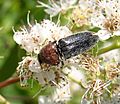Click beetle facts for kids
Quick facts for kids Click beetles |
|
|---|---|
 |
|
| Limoniscus violaceus | |
| Scientific classification | |
| Kingdom: | |
| Phylum: | |
| Class: | |
| Order: | |
| Superfamily: |
Elateroidea
|
| Family: |
Elateridae
Leach, 1815
|
Click beetles are fascinating insects known for their unique ability to "click" and jump! They are also called elaters, snapping beetles, spring beetles, or skipjacks. These beetles belong to the insect family Elateridae. You can find them almost anywhere around the world.
Click beetles get their name from the loud "clicking" sound they make. They use this sound to flick themselves into the air. This special trick helps them escape from predators. It also helps them flip over if they land on their back. A click beetle can jump between 15 and 30 centimetres high!
Contents
How Click Beetles Click and Jump
Click beetles have a special body part that lets them perform their amazing jump. They have a unique joint between two sections of their thorax (the middle part of their body). On one side of this joint, there's a small spine. On the other side, there's a groove.
To jump, the beetle quickly bends its body. It then snaps the spine into the groove. This action makes the "click" sound and launches the beetle into the air. If the beetle lands on its back, it will keep clicking until it lands upright on its legs.
About Click Beetles
The family of beetles known as Elateridae was first described in 1815. Today, scientists know about 9,300 different kinds, or species, of click beetles worldwide. About 965 of these species live in North America.
Most click beetles are fairly small, usually less than 2 centimetres long. They often have dull colors like brown, black, or gray. However, some species can be larger and very colorful. Click beetles usually look for food at night. They are not very active during the day.
Wireworms: Click Beetle Larvae
The young forms of click beetles are called wireworms. Wireworms look like small, tough worms. They usually live under the soil for three or four years. During this time, they feed on rotting plants and roots.
Sometimes, wireworms can cause damage to crops. This happens when they eat the roots of important plants. Once they are in the soil, wireworms can be very difficult to get rid of.
Images for kids
-
A click beetle on a potato plant in an Oklahoma garden.
See also
 In Spanish: Elatéridos para niños
In Spanish: Elatéridos para niños






